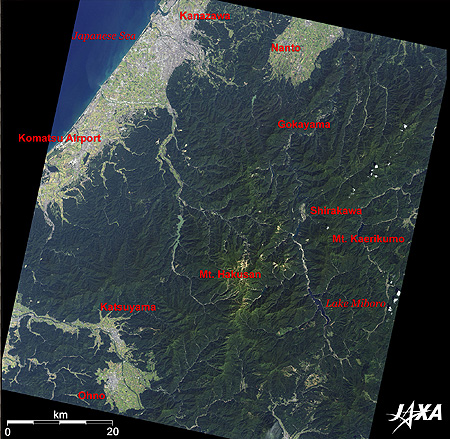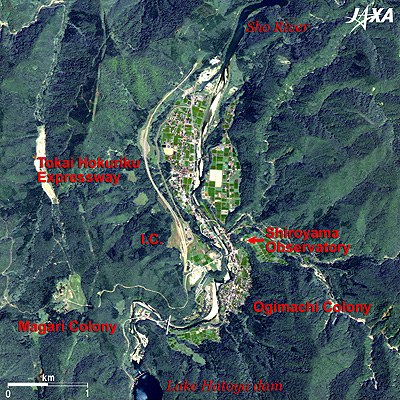Seen from Space 2009
Historic Village Shirakawa-go
Mt. Haku-san (meaning "white mountain"; highest peak (Gozenmine) 2,702 m above sea level) in the center of the image is one of the three major mountains in Japan (the others being Mt. Fuji and Mt. Tate-yama). Hakusan National Park extends 20 km east and west, and 40 km north and south, encompassing parts of Toyama, Ishikawa, Fukui and Gifu Prefectures and most mountains in the central figure. Sho River meanders from south to north on the right of Mt. Haku-san. Shirakawa Village lies on the riverbank; it is called Shirakawa-go and is traditional scene in Japan. Traditional Gassho-style colonies in a harsh natural environment still depict old Japan. Small Gassho-style colonies, Gokayama (Nanto City in Toyama Prefecture) including Ainokura and Suganuma districts are also visible at the right-angle bend of the river and 15 km north of Shirakawa-go. Historic Villages Shirakawa-go and Gokayama were added to the list of World Cultural Heritage sites of the United Nations Educational, Scientific, and Cultural Organization (UNESCO) in September 1995 as outstanding examples of traditional scenery and the environmental circumstances. On 2 December 2008, the Japan Aerospace Exploration Agency (JAXA) and the United Nations Educational, Scientific, and Cultural Organization (UNESCO) signed a cooperation agreement in monitoring World Heritage Sites using the Advanced Land-Observing Satellite "DAICHI" (ALOS) to watch and protect the common legacy of all mankind. Lake Miboro, 15km south of Shirakawa-go, is a man-made lake on the upper stream of Sho River with Miboro Dam (completed in 1961). The rock-fill dam is a 131 m-high, 405 m-long trapezoid filled with clay and sand. The over 450-year old Shogawa Cherry tree transplanted during construction of the dam is very famous. Mt. Kaerikumo, which collapsed in the great Tensho Earthquake of 1586, is known to be the home of the warrior Uchigashima family. Uchigashima was a mine engineer and mined gold near here. It may be why people lived deep in the snow-covered mountains. Kaerikumo castle and its associated business area were ruined with the Uchigashima family in one day by a great landslide during the earthquake. The 80 km-long Miboro active fault line still runs along Sho River.
Gassho-style houses are traditional buildings built from the middle of the Edo era (1600 to 1868) to the beginning of the Showa era (1926 to 1989). Many houses disappeared after 1960, but a “No sell, No rent and No destroy” preservation movement has been started. The road to the left of Shirakawa-go is the Tokai-Hokuriku expressway. An interchange of the expressway is visible. Sho River flows through Shirakawa-go. Shiroyama observation platform (Ogimachi in Shirakawa village) on the east of Shirakawa-go has a fine view of a Gassho-style village. Shiroyama is one of the forts of the Uchigashima family. Many purple Gassho-style houses dot the south of Shiroyama observation platform and on either side of Sho River. Ogimachi district has Wada, Kanda and Nagase housees, as well as other famous Gassho-style houses and museums of important cultural assets. Other Gassho-style houses are also visible in Magari district. Figure 2 presents a summer view, but snow-capped winter is the best season for visiting Shirakawa-go.
|






